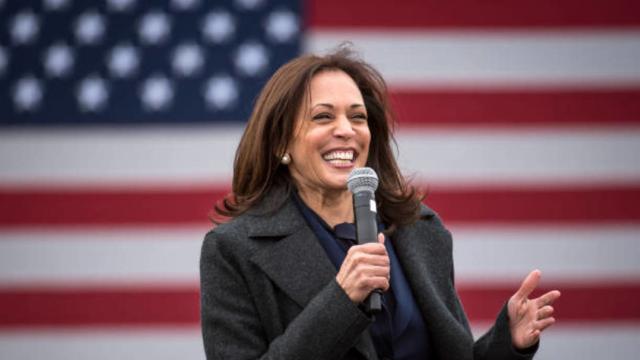YANKEE SAVE THIS
What Americans want to know about life in Canada: Gun laws, citizenship, 'emotional support Canadians'
Elianna Lev
Thu., November 5, 2020

With the U.S. election winding down, many Americans are showing an interest in moving to Canada, which has peaked interest in things such as our gun laws, who's our "president" and how they can get some support amid these hard times. (Credit: Associated Press)
As U.S. election ballots continue to be counted, many Americans, aside from checking whether Joe Biden or Donald Trump has won yet, have been mulling what it would be like to check out Canada if the election results aren’t to their liking.
But moving is never easy: once you’ve looked up how to move to Canada, some of the more nuanced parts of Canadian life may remain a mystery. Yahoo Canada is here to break down everything you need to know if you want to move to Canada from the U.S., based on some of the top searches we’ve noticed on Google Trends throughout the 2020 U.S. Election.
What is the warmest place in Canada?
Victoria in British Columbia is the most western point of the country and also happens to be the warmest. Though their winters are often wet and grey, temperatures rarely dip below freezing and snow days are a novelty. During the coldest months (January and February), Victoria sees a high of around 8°C (46°F) and a low of 3°C (37°F). In the warmest month of August, there’s a high of around 24°C (75°F) and a low of 12°C (53°F).

View of the harbour of Victoria, Vancouver Island, B.C., Canada. (Getty)
How do you move to Canada from the U.S. and get a Canadian citizenship?
There seems to be a keen interest in learning more about the process of immigrating to Canada from the U.S. There are three main ways to do so: permanent residency, work permit or a study permit. To learn more about the details of how to move to Canada from the U.S, please read here.
What is Canada’s health care system, is it free?
Canadians have access to health insurance through a universal, public system. It’s not free, but it is paid largely by Canadian tax dollars, while each province and territory has its own health insurance plan. All permanent residents and citizens also receive medically necessary hospital and physician services for free. However, many Canadians have private insurance to cover services such as dental care and prescription drugs.
What are Canada’s gun laws?
The main three classes of firearms in Canada are restricted, non-restricted and prohibited. Shotguns and standard rifles are non-restricted guns, which don’t need to be registered, unless you’re in Quebec. Certain types of handguns, like the ones small enough to be hidden, are prohibited in Canada. If a firearm is not considered prohibited, it is instead considered restricted and needs to be registered. Prohibited firearms include modified handguns and automatic rifles.
If you want to buy or possess a firearm, you’ll need to have a license. This requires completing the Canada Firearms Safety Course. If you’d like to own a restricted firearm, you must take a separate course. Once these courses are passed and you’ve received your license, it has to be renewed every five years. This is done through an application process, as well as completing a background check. Click here to learn more.
'Thank God I'm in Canada': dual citizens living in Eastern Ontario react to U.S. election
What type of government does Canada have, is it socialist?
Despite what some people may think, Canada is not a socialist country. It is a democracy with federal elections every four years at most, however if parliament dissolves prior to that date, an election may be held sooner. Canada has three levels of government: federal, provincial and municipal. On the federal level, the prime Minister is the top dog, and he, along with members of parliament in Ottawa, deal with national issues like:
taxes
money
banking
shipping
railways
pipelines
telephones
criminal law
foreign affairs
national defence
employment insurance
Aboriginal lands and rights
Parliament is broken down into three levels:
the Sovereign (Queen or King)
the Senate
the House of Commons
Canada is a constitutional monarchy, which means the queen or king is technically our head of state, while the Prime Minister is the head of government.
On a provincial and territorial level, the Premier is at the top of command. Those governments are in charge of handling issues like:
education
health care
road regulations
The municipal government is led by a mayor. These governments run cities, towns or districts (municipalities) and are in charge of issues like:
parks
parking
libraries
roadways
local police
local land use
fire protection
public transportation
community water systems
Throughout Canada, there are also First Nation communities, where band councils govern, similar to municipal governments. Decisions in the community are made by band council, which are elected by band members.
Who is Canada’s President?
Canada doesn’t have a president, it has a prime minister. Canada’s current prime minister is Justin Trudeau. Canada also has a governor general, who represents the king or queen when they are not present in the country (Queen Elizabeth II’s most recent visit to Canada was in 2010). The current governor general of Canada is Julie Payette.
What are Canada’s tax rates?
Canadian tax rates depend on your income bracket. How much you’ll be taxed depends on how much you make in a year. These amounts are adjusted each year according to inflation.
2019 Federal income tax brackets & rates
$47,630 or less
15%
$47,630 to $95,259
20.5%
$95,259 to $147,667
26%
$147,667 to $210,371
29%
More than $210,371
33%
‘Canadian tuxedo’: What is it and its origin?
This is a sartorial statement where denim is layered over several items of clothing — denim jeans with a denim shirt and a denim jacket, for example. The Canadian tuxedo is said to have first been worn by American singer Bing Crosby, who was nearly denied a hotel room in Vancouver as a result of his casual attire. Also see: Toques, flannel, and Hudson Bay blankets.

A 'Canadian tuxedo' is a term used for denim-on-denim outfits, such as a denim jacket worn with a pair of jeans, often in the same shade of blue. (Getty)
What’s an emotional support Canadian?
On U.S. election night, a Twitter user by the handle @Darth_Pingu tweeted out to Americans that there would be “Emotional Support Canadians” on standby. The tweet garnered over 20,000 retweets, and lots of engagement from Americans, looking for care packages of Timbits and maple syrup.
On a related note, most Canadians will already be familiar with the original Emotional Support Canadian.

Mr. Dressup, a.k.a. Ernie Coombs, was a mainstay of Canadian children's television for many years, entertaining youngsters from 1967 to 1996, and could be considered the ultimate Emotional Support Canadian.
(Photo by Rene Johnston/Toronto Star via Getty Images)
Fri., November 6, 2020,
Once the election results began coming out, some Canadians could sense their neighbours to the south needed support, and some Twitter users were offering their services as “emotional support Canadians.”
With the poll totals in some states moving at what feels like a snails pace,
“emotional support” people are starting to offer creative and helpful solutions
to bide the time.
While some Canadians are happy to take the load of Americans,
many are not open to the idea of residents flooding the borders
— especially if Trump is the reason they’re fleeing.
While the election result has been slow to come in
and there’s been disinformation flying about from the
Trump side, some Canadians cannot get their eyes off the chaos.
With absentee ballots being counted and a good chance results
in Pennsylvania and potentially Arizona and Nevada won’t roll in
until Friday, some Canadians are poking fun at the slow pace of
the vote counting. To be fair, American ballots are far more complex,
often with multiple choices and need to be verified with scrutineers
from both parties on hand.






